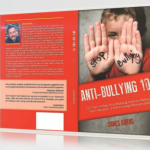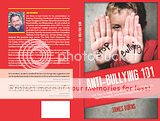- Activity – Wrinkled Wanda – On chart paper, have the participants trace an outline of a full body person. (See below for an example) Once the outline has been traced, the participants will write unkind, rude, and disrespectful statements all over the outline. These are statements that could be made to another person like, “You’re a loser, Nobody likes you, You are dumb.” Identify the drawing as a girl named Wanda. After Wanda is completely filled with a variety of negative comments, have the participants crumple the drawing, and then un-crumple it. Post the wrinkled drawings around the room. Explain to the class that these drawings are examples of what negative comments can do to a person who is bullied. Bullying comments can destroy a person’s self image and often leads to a defeated body language in the victim.
Next have the participants do the drawing again. This time write as many positive comments on the drawing as possible. Statements like, “You did such a nice job, or I enjoy your friendship. Fill it with really nice statements. Cut this drawing out, but don’t wrinkle it. Post these drawings around the room. This person is now just called Wanda. What is the difference between the two? Have the participants get into base groups and discuss how they would introduce this lesson to their students and invent any variations on the activity that would be helpful to their students.
Suicide Prevention Guide For Youth and Young Adults – Click Here
Activity – The toothpaste activity – Ask for a volunteer to come to the front of the room. Place a strip of masking tape on the length of the table. With a tube of toothpaste, have the volunteer run a bead of toothpaste on the length of the masking tape. Now ask the participant to put the toothpaste back in the tube. Obviously, it can’t be done. This is an example of how hurtful words once spoken cannot be taken back. Bullies say hurtful words frequently and need to know the impact that their words have on their victims.
Activity – Who am I? This activity requires an illustration about something that happened to me from the time I was in the 6th grade until I graduated from high school. My name is Jim and it became rather endearing to some to call me Jimbo. I really didn’t mind it but someone decided to drop the Jim at some point and call me Bo. I accepted the handle but way down deep I wish that folks would just call me by my real name, Jim. Oh, everyone meant no harm, but my parent’s, teachers, friends, coaches, all called me Bo. I didn’t have the heart to tell them that I didn’t like it. I lived with it. Once I got to college, I made everyone aware that my name was Jim. Often we as teachers can call students by names that we hear other students call them, and may not even be aware that they may not like being called certain names. Address your students by their actual name to avoid leveling the ground and jeopardizing your authority. If you have any question about this ask yourself what Beaver Cleaver’s teacher called him. “Theodore.”
Have the participants write down on a sheet of paper names that they were called when they were younger or that they may even be called now. After they have done this have them crumble up the paper and throw it in the garbage can as indicator that they will never be called this name again. Next have the participants write down on another sheet of paper what they want to be called as an indicator that this is what my name actually is.
In their classrooms teachers can have their students do this activity and write down the names that they want to be called and with the use of a name book describe all the positive attributes that that their name has connected with it. For example, James means truthful. Post the students names around the room on laminated cards and celebrate each students name, what it means, and who they are.
___________________________________________________________
Building Self Acceptance Through Positive Self-Talk: Lesson 1
Objectives:
- Students distinguish between the terms self esteem and self acceptance.
- Students discover ways to build self accetance through self talk and apply their own positive messages
Materials:
Building Self Acceptance through Positive Self Talk handout with follow-up sentences
Paper
Writing utensil
Procedure:
- Students will list on paper messages (positive or negative) they have received from other people in their lives.
- Students will determine whether or not they adopted those messages and still believe them today.
- As a group, students will read the “Building Self Acceptance through Positive Self Talk” handout.
- Students will individually complete the follow-up sentences by using the strategy of self-talk.
Closure:
Students will rate on a scale of 1-10 (ten being the most difficult) how difficult it was to finish the self-talk sentences using positive responses. Students will discuss situations in which they can use positive self-talk in the future.
Evaluation/Homework:
Students will write down five positive self-talk sentences that they will practice throughout the week.
Building Self Acceptance through Positive Self-Talk
What is self acceptance? Self accpteptance is being able to recognize your value as a person. It is essentially your level of self-worth and feeling of comfort in your own skin regardless of your faults and weaknesses. Without self acceptance, one would not be capable of reaching their full potential in life.
What is the difference between self acceptance and self-esteem?
Self esteem is a belief or feeling about yourself. It is what you believe or feel you are capable of doing. Having high self esteem can help build self acceptance.
High Self-Esteem = Feeling good about yourself
Low Self-Esteem = Feeling badly about yourself
Self acceptance is more of an action rather than an abstact sense of self. It is something you do – you stick up for yourself, you utizlize your stengths and take responsibily for your faults, and you practice loving yourself every day.
How can I build my self acceptance? Self acceptance is a reflection of beliefs you gained as a child and adolescent. It usually comes from messages you get about yourself. These messages can come from other people (like parents, teachers, or friends) or from yourself. The messages you send yourself is called “Self-Talk.” If you are used to hearing negative messages from other people, chances are you will send yourself negative messages too. Things like “I’m so stupid,” “I’m not good enough at this…” or “It’s my fault this happened” are examples of negative self-talk. One way to rebuild your self acceptance is to re-train yourself to engage in positive self-talk. Positive self-talk us when you focus on your strengths and positive qualities, reminding yourself that you are a good and valuable person.
“I am a good and caring person and deserve to be treated with respect.”
“I am capable of achieving success in my life.”
“There are people who love me and will be there for me when I need them.”
“I deserve to be happy.”
“I am allowed to make mistakes and learn from them.”
Finish the sentences below:
I am a brave person. An example of a time I was brave is
_________________________________________________________________________
I am capable of being happy. A time I was happy was
_____________________________________________________________________
I am a good friend. A time I was there for a friend was
_____________________________________________________________________
I am capable of making decisions for myself. A time I made a good decision was
_______________________________________________________________
I am loved and cared about. People who care about me are
________________________________________________________________
I am talented. Two things I am really good at are
__________________________________________________________
Click Here For 14 More Strategies – 9.99 Click To Buy Now
Understanding The Connection Between Cyber bullying and Social Media: A Comprehensive Guide
Eight Great Lesson Plans To Combat Bullying and Cyber-Bullying – FREE
Anti Bullying Writing Prompts – FREE
A Unit Plan On Resilience – FREE
A Unit Plan On Respect – 9.99 Click To Buy Now
13 Simple Anti Bullying Activities + 2 Additional Products For FREE – 8.99 Click To Buy Now
A Reflective Journal For Teachers – FREE
A Unit Plan On Resilience – 9.99 Click To Buy Now
Dealing With Parents Who Lack Respect and Responsibility – FREE
Dealing With Angry and Irate Parents Self Study Course – 24.99 Click To Buy Now





